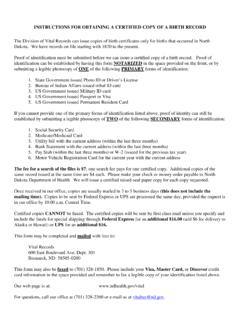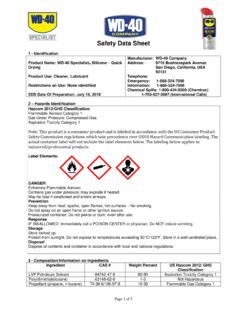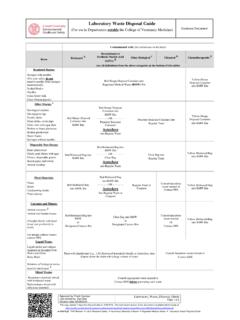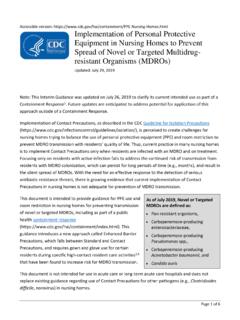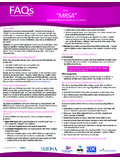Transcription of Multi-drug Resistant Organisms (MDROs) in Healthcare ...
1 Multi-drug Resistant Organisms (MDROs) in Healthcare Facilities Gail Bennett RN, MSN, CIC. 1. What we will cover: General information Specific MDROs Methicillin Resistant Staph aureus (MRSA). Vancomycin Resistant Enterococci (VRE). Extended Spectrum Beta Lactamase Producers (ESBLs). Klebsiella pneumoniae carbapenemase (KPC). Resistant Acinetobacter baumannii 2. What we will cover: Surveillance for MDROs Control Measures Isolation precautions Hand hygiene Environmental decontamination Antimicrobial stewardship programs 3.
2 Emergence of Antimicrobial Resistance Resistant Bacteria Susceptible Bacteria Resistance Gene Transfer New Resistant Bacteria 4. Methicillin- Resistant Staphylococcus aureus (MRSA). MRSA emerged in the US soon after Methicillin became commercially available in the early 1960's with the first case being detected in 1968. Increased prevalence in the 70s 5. 2000: MRSA accounted for 53% of all S. aureus clinical isolates from patients with nosocomial infections acquired in US ICUs (NNIS). 2003: the percentage had increased to (NNIS).
3 6. The 1st identification of MRSA in LTCFs was in 1970 but it was uncommon in LTC. until around 1985. 7. Methicillin- Resistant Staphylococcus aureus (MRSA). Resistant to methicillin, oxacillin, and nafcillin Transmitted by direct and indirect contact No more virulent than MSSA. Susceptible to common disinfectants 8. Risk Factors Contributing to MRSA. Colonization/Infection for all Facility Types Poor functional status Conditions that cause skin breakdown Presence of invasive devices Prior antimicrobial therapy History of colonization 9.
4 Specific Risk Factors for MRSA. Colonization in LTCFs Male gender Pressure ulcers Urinary incontinence Antibiotic therapy Fecal incontinence Hospitalized within Presence of wounds the previous 6 months 10. What patients are more likely to shed MRSA and need contact precautions? Heavy draining wound Incontinent, diarrhea, colostomy Cannot/will not contain secretions and excretions Very poor hygiene Difficult behaviors that may increase the risk of transmission Other 11. Treatment Regimens for MRSA. Infection Vancomycin is the drug of choice Disadvantages of Vancomycin expensive parenteral administration ototoxicity can potentiate nephrotoxicity of aminoglycosides 12.
5 Treatment Regimens for MRSA. Infection Linezolid (Zyvox) has been an alternative to Vancomycin treatment of MRSA since 2000. Administered orally 13. Colonization/carrier state of MRSA by Healthcare Workers Do not routinely culture staff for colonization with MRSA. It may be needed as part of an outbreak investigation HCW epidemiologic link to transmission Before culturing, Get expert consultation Have an action plan in place! 14. Outbreak control Contact precautions with observation for compliance Hand hygiene If a decision has been made to culture staff for nasal colonization: Mupirocin has been shown to be somewhat effective.
6 15. Vancomycin- Resistant Staphylococcus aureus 1st case in US, June, 2002, Michigan; 2nd case - September, 2002, Pennsylvania Vancomycin Resistant gene transferred from VRE in same patient To date, the US has had approximately 11 cases of VRSA. CDC recommends private room, contact precautions Reportable to your state and CDC. 16. Vancomycin- Resistant Staphylococcus aureus Excellent document: CDC. Investigation and Control of Vancomycin-Intermediate and . Resistant Staphylococcus aureus (VISA/VRSA), September, 2006.
7 17. What about surveillance cultures to find all patients/residents colonized or infected with Resistant Organisms ? Not routinely recommended for acute care, LTCFs, or other Healthcare facilities May be needed in an outbreak Must have an action plan before you start culturing I would suggest a consult with the state epidemiology office first 18. Active surveillance cultures: CDC says, More research is needed to determine the circumstances under which ASC are most beneficial but their use should be considered in some settings, especially if other control measures have been ineffective.
8 CDC MDRO Guideline, 2006 19. However, hospitals have a relatively new process for surveillance screening for MRSA - Example: All admits from LTCFs, jails, prisons Anyone on dialysis ICU/CCU admissions CABG patients Orthopedic patients: total joint replacements Neuro: open back Wounds/cellulitis 20. Are hospitals screening all admissions for MRSA? No, only a small % of their admissions fall in their high risk categories and get screened 21. So do we isolate admissions to LTCFs from the hospital who were culture positive for MRSA in the nares?
9 No, not if that is the only site of MRSA. identified We will be alert to the fact that the resident is colonized and alert to any new Healthcare associated MRSA cases should they develop 22. Vancomycin- Resistant Enterococcus (VRE). Enterococcus faecalis Enterococcus faecium Contact Precautions - culture negative prior to discontinuing precautions? CDC now says we need to decide when to d/c precautions but it may be prudent to have negative culture(s) prior to d/c of isolation 23. Why contact precautions for specific Organisms ?
10 Environmental contamination 24. The Inanimate Environment Can Facilitate Transmission X represents VRE culture positive sites ~ Contaminated surfaces increase cross-transmission ~. Abstract: The Risk of Hand and Glove Contamination after Contact with a VRE (+) Patient Environment. Hayden M, ICAAC, 2001, Chicago, IL. 25. Resistant Acinetobacter baumannii Aerobic gram-negative bacillus High level of resistance High numbers of A. baumannii infection among our troops in Iraq Causing outbreaks in Healthcare facilities Contact Precautions See attached example 26.
